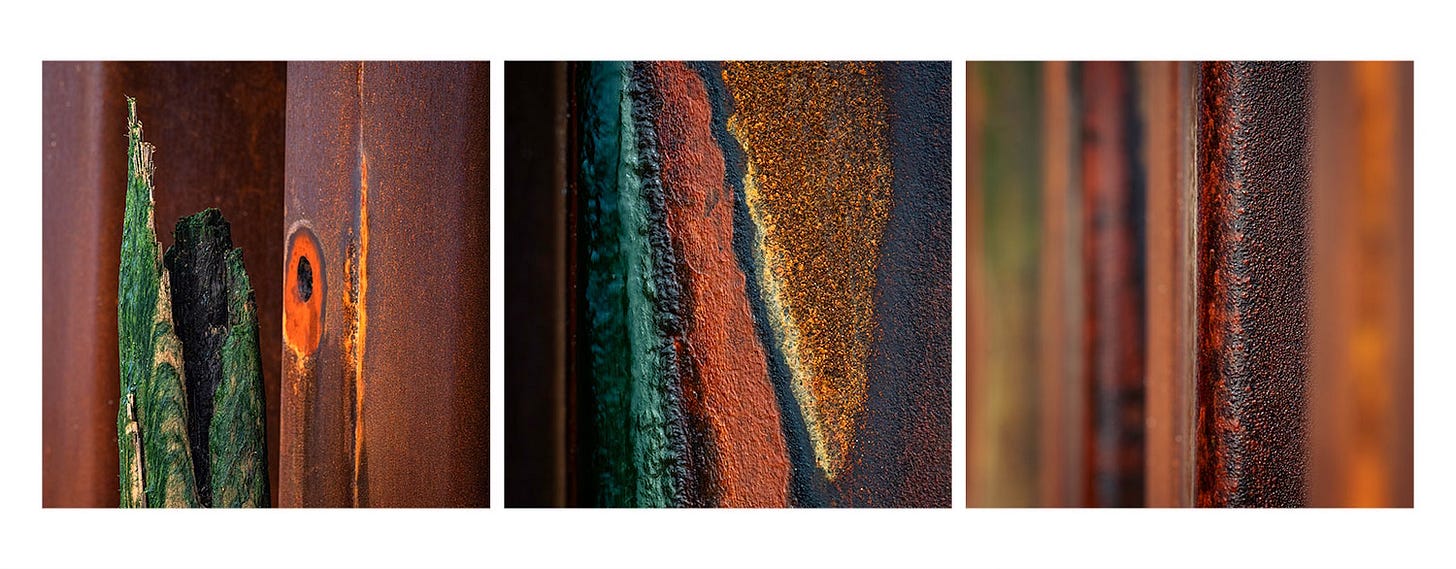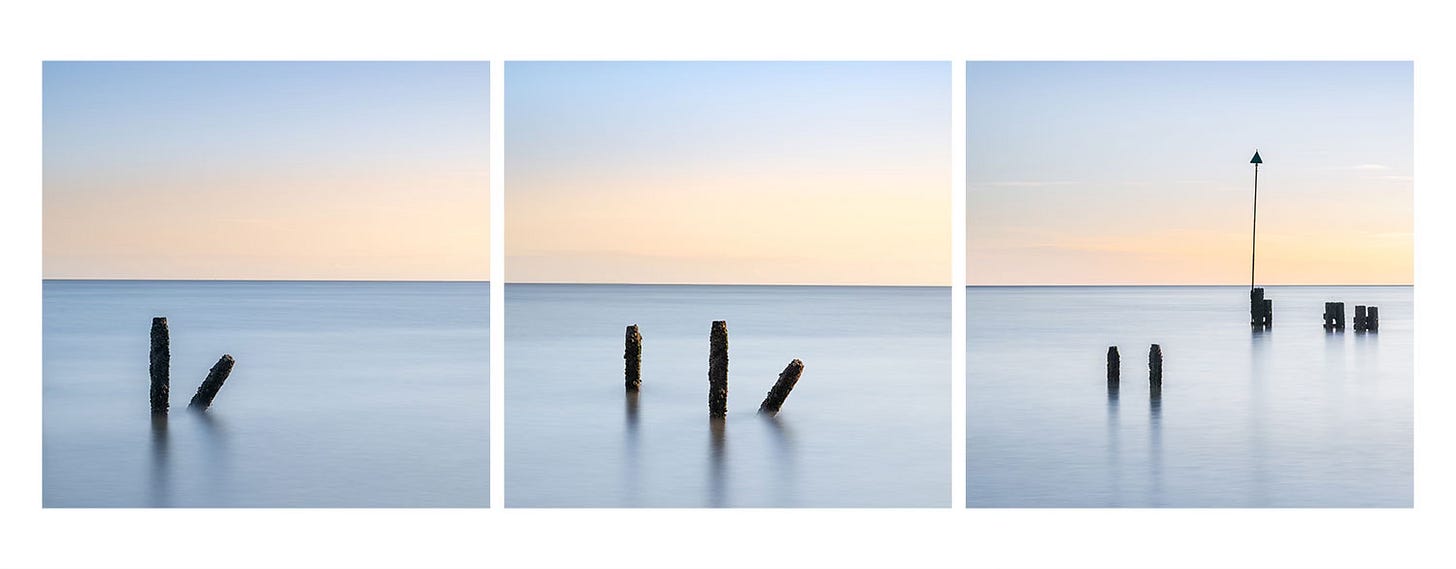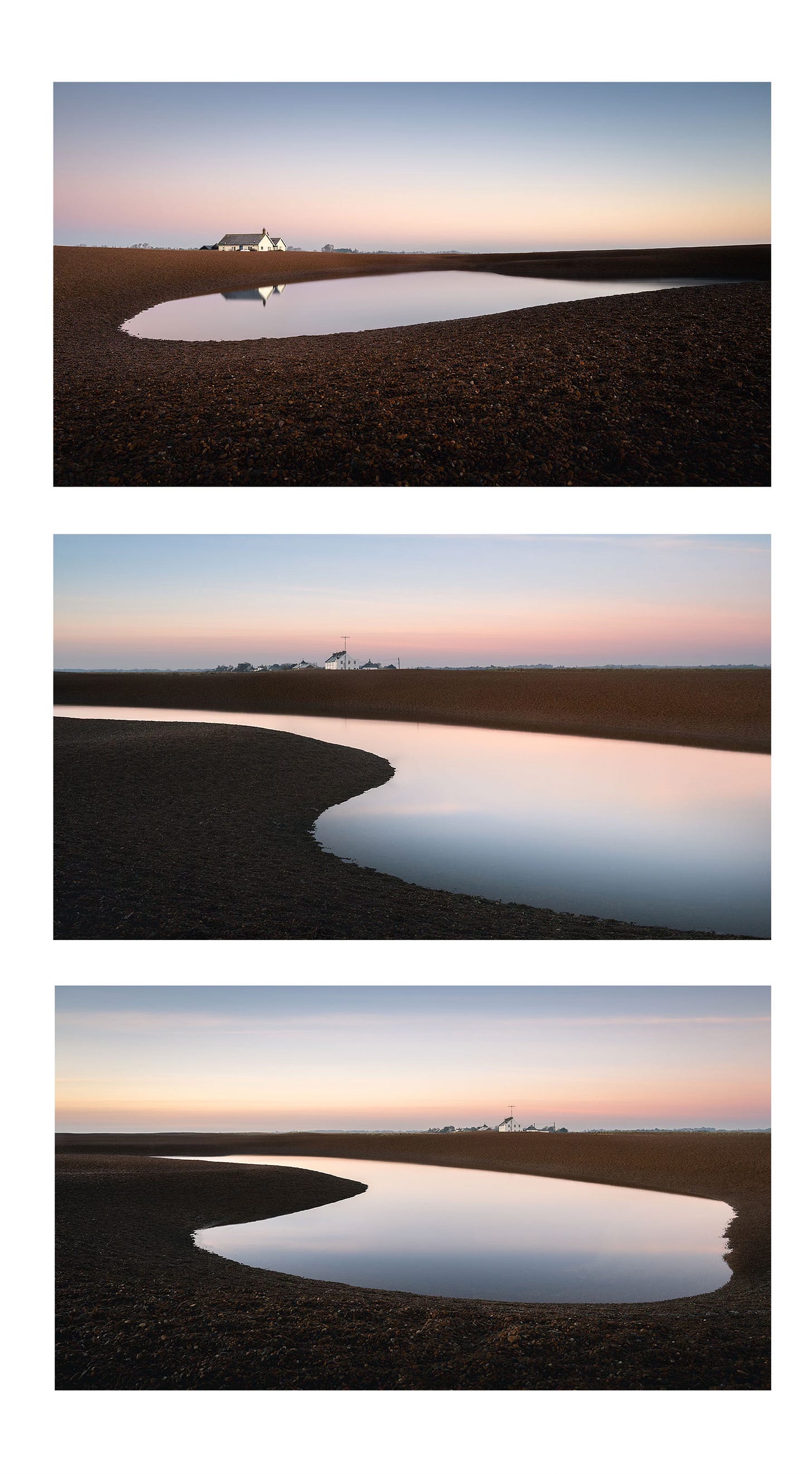Hello, I’m Gill and I write a photography blog inspired by the landscapes of Suffolk and beyond. Please subscribe to read more of my writing and visit my website to view my images.
Last week I ran my first mini project workshop with 4 participants who were all tasked with the challenge of producing a triptych of images at two different coastal locations. The brief was to create two panels; one from each location which explored the ideas of shape, motion or texture.
When I set the workshop challenge I had just finished my Kingdom of Rust project and I had been experimenting with triptychs for a while so I figured it would be a fun and fairly straight forward task. How hard could it be to combine 3 images into a panel? Well as it turn out, fairly difficult!
A triptych is a panel of three associated or connected images which all work together to tell a story. They can be different views of the same subject or different subjects that are related in some way. They can sit side by side in a horizontal panel or one on top of each other in a vertical orientation, but however they are displayed they should compliment each other and work together to create a visual display that is greater than the sum of its parts.
My workshop began on the beach at Bawdsey where I created my Kingdom of rust project and the participants spent a happy morning photographing everything from the motion of the sea, to the textures and colours in some of the sea defences. On the second day we moved a couple of miles along the coast to Shingle Street which has some beautiful curves in its coastline at low tide.
At both locations there was plenty to photograph and everyone produced some lovely stand alone images, but did they create enough shots to make successful triptychs?
The answer is that everyone struggled to produce 2 triptychs and most found the process much harder than they had expected. I thought it would be interesting to discuss the reasons why using some of my own images that I look outside of the workshop. There is definitely more to combining 3 images than you might think.
To begin with the participants were hampered by the fact that the locations were new to most of them. They hadn’t had the benefit of working in them before so they had not been able to pre visualise their shots, so apart from my suggestions they were going into the challenge almost blind. For a triptych this was definitely a disadvantage.
When I was putting together my Kingdom of Rust project I spent a lot of time organising images and collating them into sets that I felt worked well together. So when I came to think about the workshop I could easily put together a couple of panels that I felt worked using the metal wall and textures as my subject.
I think the reason that I found these panels relatively easy to construct was because they were detail shots and didn’t include a horizon. Creating a panel of landscape shots is much harder.
Returning to Bawdsey I photographed lots of seascape images with the posts and old wooden groynes. As I was working I was thinking not just about each individual shot but about how I might combine them together to form a panel. I was having to consider the light, the colours, the flow from one composition to the next and also the position of the horizon within the frame. When you look at a triptych panel it should have a symmetry about it and the images should flow beautifully from one to the other. If the lighting or colour pallet is too different then the visual flow will be disrupted and the panel won’t work.
I took some nice stand alone images because the light was lovely but many of them did not work well together. In the end I came up with the following panel which I was happy with. To create this I spent a long time in Lightroom toning the colours in the three images so they matched exactly. I considered how the crop would work and where the horizon would sit in the frame and I also thought about the visual orientation of the structures and how this created a flow through the triptych. In terms of time, this panel took well over two hours to produce.
Heading to the second location at Shingle Street I found constructing a panel using more complex landscape images even harder. There are some lovely shots to be had here but creating three that combined well together was more challenging than I had imagined.
My idea was to use the pools on the shingle beach to create three images that were all about shape. I went at sunrise to try and make the most of the light but I found I had to work extremely quickly to ensure I had three shots that were all taken in similar conditions. With this piece I decided that it just didn’t flow well in a horizontal format so I used three images stacked vertically to construct my panel.
I tried to put a right facing image at the top, a static image in the middle and a left facing image at the bottom. For me this created the best flow within the panel. Lighting was again tricky and I had to run round the pool taking all the images before the sun cast any shadows across the scene. I must have looked like a photographer possessed!
Overall I found this a fun challenge and a really interesting one to undertake. Producing a panel is nothing like producing a single image, it is much more complex, but it does introduce skills such as colour grading and working with visual flow, design and balance, that would be useful for book making or larger projects in general. As for my workshop participants they all went home with a printed panel from at least one location and they all agreed the challenge was much harder than they first imagined.
Panel projects are definitely worth considering if you want to move your photography away from stand alone images. Creating a triptych is a great start and as I have shown is more complex than you may first imagine. However I think it is worth the time and will definitely help you see more, think more and consider all aspects of your composition much more. If you have time I think it is worth the challenge.
My next panel workshop will run from 17th - 18th February.
What are your thoughts on panels and triptychs, are they something you would try in your own photography? It would be lovely to hear your thoughts on my image combinations, panels in general or any larger photography projects you have undertaken. Please leave a comment below.
Thank you very much for reading and until next week enjoy your photography.
Gill









Very interesting article and an insight into how difficult it is to produce a triptych panel. My thoughts are that the first panel could be a pano shot that has been dissected into 3 separate shots and the second panel I feel would look more balanced with the first ( very nice shots) shot as the middle shot. Just my personal thoughts.
I think your comment about it being very hard if you go in blind is spot on. Seems to me you need to go out with the explicit aim of creating a triptych and have a reasonable idea how you're going about it. Otherwise (like me) you get home and think "I wonder if these will work as a panel" and they probably don't. For example, in your three Shingle Street images, if I was just going to shoot the top one (which I love, by the way - nice and minimalist!) as a stand-alone image I might have wanted less foreground in it, but when it's with the other two you see why you need the foreground. Doing that retrospectively might not be possible.